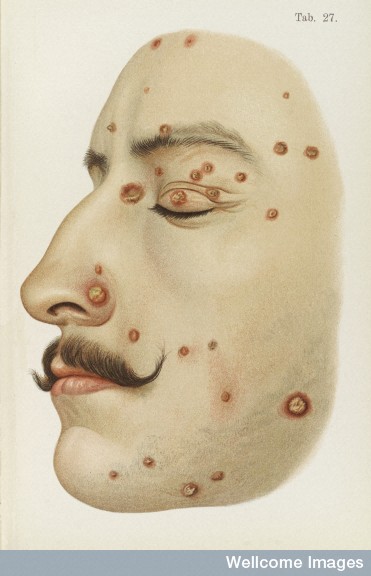 Syphilis. The word conjures the worst of fears–along with a set of relatively unpleasant images! Caused by the bacterium Treponema pallidum, syphilis has four stages:
Syphilis. The word conjures the worst of fears–along with a set of relatively unpleasant images! Caused by the bacterium Treponema pallidum, syphilis has four stages:
- primary (wherein a single sore, or chancre, appears),
- secondary (characterized by skin rash and lesions of mucous membranes),
- latent stage (when symptoms disappear) and
- late stage (wherein the disease attacks the nervous system and internal organs).[1]
It affected the hair and nails, mucous membranes, tongue, larynx, abdomen, arteries, muscles, eyes and ears, nerves and–of course–the brain. Syphilis was dangerous in part because it could go “underground” in a sense, and people who looked perfectly healthy might yet have the disease. Even more frightening was its effects on children–for the disease could be transferred in-utero.
The link between syphilis and birth had been discovered as early as the 16th century (about 100 years after the initial European outbreak), but social debate and legal action focused for most of the century on the prostitute—the ostensibly “non-productive” sexual woman—as both source and disseminator of the disease. By the 1890s, British medical authorities suggests that there were specific signifiers and predispositions that not only “inscribed” women’s bodies with the “signs of degeneracy,” but also determined that some women were born as prostitutes, congenitally “loose” in terms of morals and aggressively sexual (Spongberg 1). By “pathologizing the prostitute, male responsibility” could be “overlooked”; more specifically, the infection of innocent wives and the birth of syphilitic children could be attributed to the prostitute (11). This repositioned the locus of disease upon a woman who was both signally degenerate and, due to venereal infection, often sterile,[2] but of course, the problem of congenital syphilis remained!
In recognition that syphilis could “reach down into the next generation,” France instituted its own réglementation, the registration and regular examination of prostitutes. This procedure was justified as the means of saving “respectable wives” from diseases (Harsin 72). The underlying assumption in England, as in France, is that regulation of prostitutes (as primary disease carriers) will prevent wives from receiving the disease because it will keep the husbands free of it. What rarely appears in this rhetoric is the husband’s culpability for his actions. However, by the time of World War I, the concern over venereal disease shifted from the locus of the family to the front lines of battle. Luckily, by this time, there was the first truly systematic and successful treatment.
SALVARSAN 606
In 1906 Paul Ehrlich, the famous German physician, discovered Salvarsan 606 and Neosalvarsan 614, the world’s first chemotherapeutic agents for systemic treatment of a micro-organism. Sahachiro Hata and Paul Ehrlich discovered the compound in 1909. Ehrlich’s team was the first organized team effort to optimize the biological activity of a lead compound through systematic chemical modifications. They first studied the reaction on animals, particularly mice and rats. Wilhelm compiled his findings in The Treatment of Syphilis with Salvarsan (which had an introduction by Ehrlich) and provides many cases of healing where erosive chancres recede within forty-eight hours. As the author explains:
As a result of these and similar observations, the superiority of the new remedy over those hitherto known was fully demonstrated and I therefore felt justified in assuming the risk that naturally attached to any new remedy. [3]
Those risks, it turned out, were very serious; treatments were often by injection and Salvarsan itself was poisonous and potentially deadly. As related by Dr. Wilhelm Wechselmann in his 1913 book The Pathogenesis of Salvarasan Fatalities:
Of all the clouds which have encompassed salvarsan therapy there yet remains one to darken the horizon, but this is the blackest, viz: the foudroyant fatalities in consequence of the intravenous injections of salvarsan. There cannot be the least doubt but that these […] patients would not have died at the time had it not been for the introduction of salvarsan into their veins.[4]
Despite the availability of a specific cure, and the use of the Wassermann test for diagnosis, syphilis was a major problem affecting the health of soldiers on the Western Front–partly because not every soldier knew (or admitted) to having it. [5]
In some ways, then, even having a cure for so deadly a disease–and one marked by horrid pain, lesion, sores, and deterioration–did not necessarily bring a sudden end to the epidemic. In this series (Of Syphilis and…) we will be considering not only the progression of the disease but also of its cure, including the public health bulletins and campaigns of the “social hygiene” movement.
[1] Syphilis and other forms of venereal infection led to miscarriage and birth defects, though in the rhetoric of physicians like William Acton, sterility was the proper “wages of sin.” Qtd. in Spongberg, 51. [2] “Syphilis—CDC Fact Sheet.” Centers for Disease Control and Prevention. 9/16/2010. Accessed 6/10/2012. http://www.cdc.gov/std/syphilis/STDFact-Syphilis.htm [3] Wilhelm Wechselmann. The Treatment of Syphilis with Salvarsan. New York Rebman Company 1911 [4] Wilhelm Wechselmann. The Pathogenesis of Salvarasan Fatalities. Fleming-Smith 1913 [5] J. E. R. McDONOUGH FRCS. “The Treatment of Syphilis in 1915” Accessed 10/25/2013 http://www.vlib.us/medical/syphilis.htm
